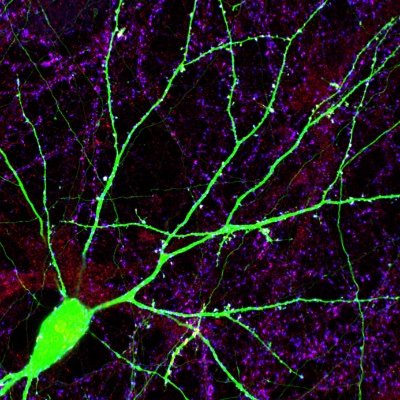
Johannes Bohacek
@BohacekLab
Followers
3K
Following
7K
Media
536
Statuses
4K
Dad. Associate Professor @eth_en, studying stress, behavior, hippocampus, noradrenaline and the mighty locus coeruleus Here to learn, share, laugh and rant.
Zurich, Switzerland
Joined May 2017
We just released the largest amount of stress profiling data from our (any?) lab so far! How does the molecular stress response adapt as an acute stressor becomes chronic? Multiomic profiling in the 🐭 hippocampus, led by @RebeccaWaag and co-last author Pierre-Luc Germain! 💪
Distinct molecular mechanisms of stress habituation in the mouse hippocampus https://t.co/3QC3Rdi8Rh
#biorxiv_neursci
2
8
35
Our study describing a role for the circular RNA circRERE in the regulation of silent excitatory synapses is finally out @NatureComms!
nature.com
Nature Communications - Here authors use RNA interference to identify circular RNAs involved in synaptogenesis. They report that the candidate circRERE inhibits the formation of silent synapses via...
1
6
22
Stellar women-only (💪) panel on stress and development, loaded with cutting-edge multiomic data kicking off the European Stress Conference #ESC2025 in Innsbruck, Austria
0
2
6
Most importantly: We developed an automated, portable pain and welfare monitoring system (combining "mouse grimace scale" and full-body pose-estimation with behavior flow analysis). Brilliant work by @osturmscience, the @ETH_en 3R-Hub and our collaborator Katharina Hohlbaum. 💪
0
0
3
Note: Modest grimace pain levels remain detectable for 24hrs after surgery. Neither meloxicam (5mg/kg) nor the combination of meloxicam(5mg/kg)+buprenorphine(0.1mg/kg) could eliminate these remaining pain levels. We detect strong side-effects from opioid treatment (hyperactive).
1
0
0
How much analgesia is needed to manage pain levels in mice after brain surgeries? A single dose of meloxicam seems to be enough. Even the addition of opioids cannot provide a clear benefit (in line with recent work from others, see refs in our preprint): https://t.co/Ztrjfybfqj
biorxiv.org
Pain and welfare monitoring is essential for ethical animal testing, but current cage-side assessments are qualitative and subjective. Here we present the GrimACE, the first fully standardised and...
1
17
46
And saving the best for last: We integrate these results with previously published bulk and single-cell data from our lab and make these data freely accessible and searchable through an interactive app ( https://t.co/dSeZGEtA0P). We hope people like this resource - please RT! 🙏
0
0
1
On a single-cell level, we reveal blunted chromatin accessibility changes after chronic stress for cAMP signaling, and a damped response that returns to baseline much faster for glucocorticoid receptor binding. This again points to two parallel mechanisms of habituation.
1
0
0
We replicate the profound damping of transcription on a single-cell, multi-omic level (24 biological samples), showing cell-type specificity in stress-induced transcriptional changes and diverse temporal dynamics. It seems that fewer neurons get activated.
1
0
1
Bioinformatic and experimental approaches identify two parallel, independent mechanisms of habituation: an early blunting of transcription due to cAMP signaling, and a late blunting related to corticosterone signaling at the glucocorticoid receptor.
1
0
0
We find that the transcriptional stress response dramatically habituates in every animal, profoundly blunting every stress induced gene. Habituation is already established after 10 days. There is no emergence of adaptive responses, and no change in baseline gene expression 😱!
1
0
0
First, we profiled the transcriptomic and chromatin accessibility response to an acute restraint stress challenge over time. Then we repeated this after 10 and 20 days of stress exposure (192 biological samples for transcriptomics, 32 for ATAC-seq).
1
0
1
With best wishes for 2025, I bid farewell to this communication channel. I am following various colleagues from the university world and industry who have withdrawn from X in recent months. Feel free to follow the official social media channels of @ETH_en. Happy New Year to all!
0
1
40
Opportunity of a lifetime! Join us as a professor at @ETH_en !
0
4
3
At its meeting on December 5, 2024, the ETH Board appointed nine professors at the request of ETH President Joël Mesot. In addition, the title "Professor" was awarded twice. https://t.co/GWFNlqMawI
ethz.ch
At its meeting on December 5, 2024, the ETH Board appointed nine professors at the request of ETH President Joël Mesot. In addition, the title
0
4
31
@LabLuthi uncovers a dual role of #locus @coeruleus in #sleep -> 1) its strict gatekeeper role for the sleep cycle 2) the partial brain-body arousals it generates. Powerful minds behind all this: @alejandrosoriof @GFoustoukos @CardisRomain
https://t.co/Gvxt0ZwerO
nature.com
Nature Neuroscience - Lüthi and colleagues show that activity of the locus coeruleus (LC) is crucial for the cyclic alternation between non-rapid-eye-movement and rapid-eye-movement sleep....
13
47
138
We did it. We killed neuro twitter and it's resuscitation it's happening somewhere else. Come join us! https://t.co/E4aEGyOlvf
thetransmitter.org
Daily neuroscience-related posts on the social-media platform this week have increased more than 400 percent, on average, compared with October.
7
37
129
https://t.co/4lWBNq9u7E I know I'm late to the game, but hey... @bohaceklab.bsky.social
science.org
After recent changes to Elon Musk’s X, a gradual migration turns into a stampede
1
0
0
I have to thank the editor Nina Vogt, the editorial process was very supportive, fair and efficient. The reviewers asked for a lot, but it clearly improved the paper a lot. For a thread on the work, follow this link:
BehaviorFlow from the @BohacekLab is an analysis package that overcomes challenges with multiple testing when dealing with large numbers of behavioral variables and limited data. BehaviorFlow also allows combining datasets from different experiments. https://t.co/jHkrtyDJeJ
0
3
23













